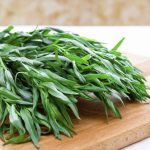 A spice from the leaves of an Astor plant that are dried, ground and used to flavor fish, meats, salads, etc. A sweet, mint-like flavor.
A spice from the leaves of an Astor plant that are dried, ground and used to flavor fish, meats, salads, etc. A sweet, mint-like flavor.
The leaves of the tarragon plant were once thought to cure snakebites; this notion may have led to the herb’s name, which derives from a Greek source meaning little dragon. The Greek name for the herb—drakontion, a diminutive of drakon, meaning dragon—was first adopted by Arabic as tarkhun. The Arabic tarkhun was then borrowed by Spanish as taragona, which in the early sixteenth century became the English name for the herb, tarragon. In the seventeenth century, tarragon was also sometimes called serpentine or garden dragon, which suggests that the fire-breathing origin of the word tarragon was well known. The history of tarragon also extends beyond its Greek origin: the Greek drakon developed from an Indo-European source meaning to glance at, thanks to the monster’s ability to paralyze, if not kill, by simply looking at its victim.
Tarragon is an herb that belongs to the wormwood family and is highly appreciated for its aromatic qualities that add flavor to vinegar, meat, poultry, fish, salads, sauces, and some vegetables. It is originally from the temperate zone and grows up to about eighteen inches in height. It has dark green pointed leaves that are widely spaced and small clusters of greenish-yellow flowers.
Presenting an intriguing botanical specimen akin to wormwood, we encounter an aromatic herb distinguished by its elongated, slender leaves and a subtle hint of licorice essence. This particular herb manifests in two distinct varieties, namely Russian and French, with the latter exhibiting a more delicate and refined flavor, making it the preferred choice for culinary applications. Notably, French tarragon finds its place in the creation of tarragon vinegar, a condiment highly esteemed by the French for blending with mustard. Its harmonious affinity with poultry and seafood renders it an ideal companion in the realm of gastronomy, being the quintessential seasoning to elevate the flavors of tartar sauce.
